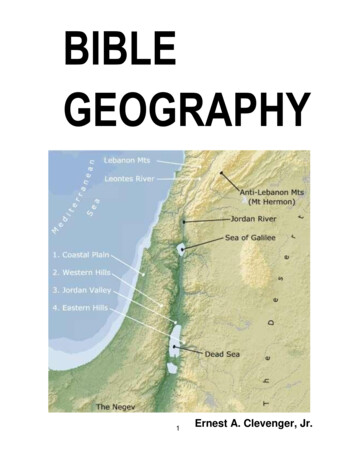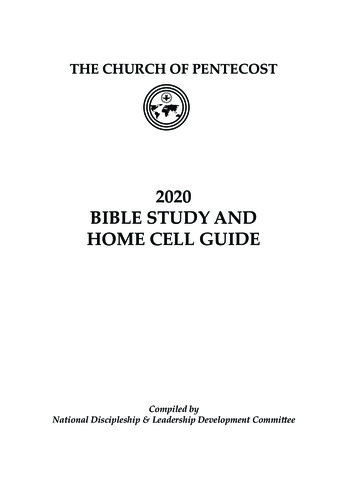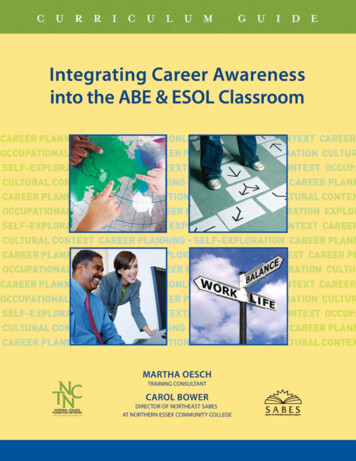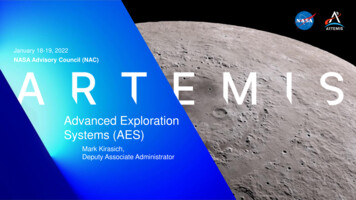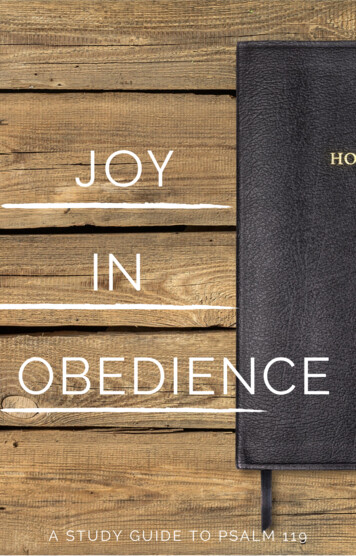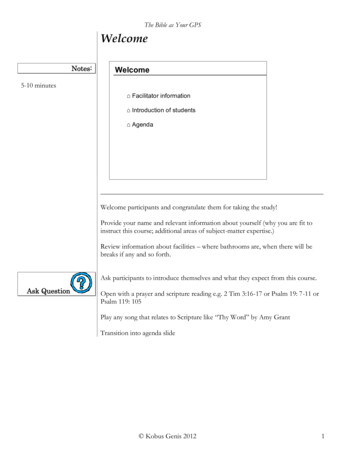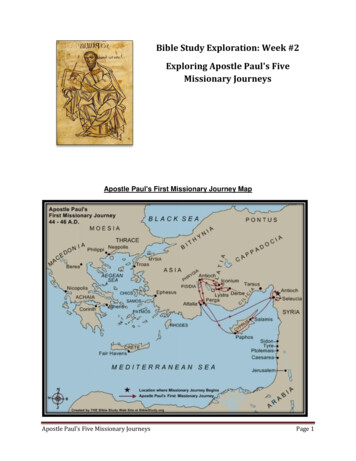
Transcription
Bible Study Exploration: Week #2Exploring Apostle Paul's FiveMissionary JourneysApostle Paul's First Missionary Journey MapApostle Paul's Five Missionary JourneysPage 1
Footnotes from Paul's First Missionary JourneyThe Apostle Paul and Barnabas are considered prophets (teachers) in the early New Testamentchurch like several others. The brethren of Antioch in Syria lay hands on both men and ordain them asapostles in the late Spring of 44 A.D.While they (the church in Syrian Antioch) were serving the Lord and fasting, the Holy Spirit saidto them, 'Set apart for me Barnabas and Saul, to do the work to which I have called them.' (Acts 13)From Antioch Paul, Barnabas and John (surnamed Mark) begin a missionary journey (Acts 13:4 52, 14:1 - 25). It is the first such extensive evangelistic tour taken by Paul. The evangelism team travelsto Seleucia then sails to Salamis, the principle city and seaport of the island of Cyprus.Why did Paul choose, as the first place he would evangelize on his initial missionary journey, totravel to the island of Cyprus? While the Bible is silent regarding the exact reasons why Cyprus waschosen, we can understand why it was visited first based on the following facts.1. The island, the third largest in the Mediterranean, was fairly close to the mainland. At its closes pointCyprus is only about 63 miles (101 kilometers) from mainland Syria.2. Cyprus' proximity to the mainland made it a good migration destination for Jews, who had probablybegun to settle there even before the time of Alexander the Great. When Paul visited he was able topreach the gospel in not just one but several synagogues (Acts 13:5).3. The island was the home of fellow traveling companion and apostle Barnabas (Acts 4:36). It may havealso been a former residence of John Mark, who was a cousin of Barnabas (Colossians 4:10).Paul and company cross the island by foot and arrive at Paphos. While in Paphos the island'sRoman governor requests Barnabas and Paul meet with him so that he can personally hear the word ofGod. Accompanying the governor to the meeting is a sorcerer and false prophet known as Elymas themagician.Acts Ch 13: 9-12 Saul's name now is known as PaulBut Saul, also known as Paul, filled with the Holy Spirit, looked intently at him and said, “You son of thedevil, you enemy of all righteousness, full of all deceit and villainy, will you not stop making crooked thestraight paths of the Lord? And now listen—the hand of the Lord is against you, and you will be blind fora while, unable to see the sun.” Immediately mist and darkness came over him, and he went aboutgroping for someone to lead him by the hand. When the proconsul saw what had happened, he believed,for he was astonished at the teaching about the Lord.Apostle Paul's Five Missionary JourneysPage 2
Apostle Paul's Second Missionary JourneyFootnotes from Paul's Second Missionary JourneyPaul's second missionary journey began in the spring of 49 A.D. when he set out from Antioch,Syria, to visit the churches he had established in Asia Minor on his first journey.Some time later (after staying in the city of Antioch for about three years) Paul said toBarnabas, 'Let us go back and visit the believers in every town where we preached . . . ' (Acts 15)During this second journey Paul was inspired to take the gospel to Europe for the first time. Thissecond missionary journey ended forty months later with Paul's arrival at Jerusalem during the fallfestival season in 52 A.D. This journey is covered from close to the end of Acts 15 to Acts 18:21 - 22.The New Testament also reveals that the Corinthian fellowship was established by the apostlePaul during his second missionary journey (Acts 18:1-11; 1Corinthians 2:1 - 2).Apostle Paul's Five Missionary JourneysPage 3
Three years after establishing the church Paul wrote an epistle to the Corinthians that we nowrefer to as 1 Corinthians. This was, however, not the first epistle Paul had sent to them. We know therewas at least one previous epistle because of Paul's comments in 1Corinthians 5:9.This letter, apparently a relatively short one, was written to address the corrupting influencethat the Corinthian believers were being exposed to by permitting a fornicator to assemble with thechurch (see 1Corinthians 5). The fornicator was apparently a young man who was cohabiting with hisfather's wife (his stepmother).Paul visited Ephesus for a short time on the return leg of his second missionary journey, plantinga fellowship at Ephesus and leaving Aquila and Priscilla in the city to serve the brethren there (Acts18:19). Some of these brethren may have been believers since Pentecost of 30 A.D.Paul stayed on with the believers in Corinth for many days, then left them and sailed off withPriscilla and Aquila for Syria . . . 19 They arrived in Ephesus, where Paul left Priscilla and Aquila. (Acts 18).Apostle Paul's Five Missionary JourneysPage 4
Apostle Paul's Third Missionary JourneyFootnotes from Paul's Third Missionary JourneyPriscilla and her husband Aquila attend an Ephesians synagogue and hear a man named Apollos.Born a Jew in Alexandria, he had a special talent as an eloquent and forcible speaker. He was likelytrained in the rhetorical schools near the city of his birth. The scriptures state that he was "mighty" inregard to understanding and explaining the Scriptures. He was also very zealous for God and forpreaching the truth. Although no doubt eloquent in speech, Apollos had a major flaw that was notnecessarily of his own making. He deficiency was that he only about Jesus through the preaching of Johnthe Baptist (see Acts 19).Aquila and Priscilla decide to help Apollos by giving him more complete information regardingthe Messiah. They introduce themselves to him and are soon filling in all his gaps of knowledge in the"way of the Lord."Apostle Paul's Five Missionary JourneysPage 5
Apollos, after coming to a much broader understanding of the gospel message, expands hisservice into Achaia. The brethren in Ephesus even write a recommendation letter encouraging otherdisciples to accept and listen to what Apollos has to say. Wherever he goes he preaches about theMessiah. His ability to explain and expound the scriptures is such that the Jews cannot counter hisarguments that, indeed, Jesus is the Messiah of man.The apostle Paul ultimately meets Apollos and considers him a fellow preacher of the gospel.The next few times Apollos is mentioned in the Bible is in the book of 1Corinthians. In 1Corinthians 1Paul chastises the Corinthian church for their party spirit of aligning themselves behind particularpreachers like him, Apollos or Peter (verse 11). He reiterates his point regarding their immaturebehavior of 'playing favorites' by again mentioning Apollos (1Corinthians 3:4). In his closing remarks tothe church at Corinth, Paul states that his fellow laborer is not all that eager to revisit them (no doubtdue to the party spirit he saw for himself when he visited - see Acts 19:1).Now, about brother Apollos. I have often encouraged him to visit you with the other believers,but he is not completely convinced that he should go at this time. (1Corinthians 16:12)Apostle Paul's Five Missionary JourneysPage 6
Apostle Paul's Fourth Missionary JourneyFootnotes from Paul's Fourth Missionary JourneyAfter spending roughly two years in Caesarea's prison Paul requests, in 60 A.D., that RomanGovernor Festus send him to Rome to have the case against him heard by Caesar. Festus obliges Pauland soon a Roman soldier named Julius is charged with taking him to the empire's capital. Juliusbefriends Paul and allows him certain liberties such as seeing friends in Sidon.They delivered up Paul and certain other prisoners to a centurion named Julius, who was of the band ofAugustus . . . And Julius treated Paul kindly, allowing him to go to his friends to refresh himself. (Acts 27)The first part of Paul's journey to Rome is somewhat uneventful. After boarding another ship inMyra bound for Italy, however, the trip begins to take a turn for the worse. The ship leaves Myra with276 total people aboard her (Acts 27:37). Since strong winds forbid the vessel from sailing in a westerlydirection directly toward Italy, it sails South toward the shelter of the island of Crete. . . so we sailed down the sheltered side of the island of Crete, passing by Cape Salmone. 8 Wekept close to the coast and with great difficulty came to a place called Safe Harbors (called 'Fair Havens'in other translations), not far from the town of Lasea. (verses 7-8)The ship docks for a short period in Fair Havens until it is after the holy day known as the Day ofAtonement ('the annual fast day'), which fell in 60 A.D. on September 24th.Apostle Paul's Five Missionary JourneysPage 7
The optimal period for navigating the Mediterranean Sea was, in the first century, from April toOctober. Because of the winds, stormy weather and inability to see either the sun or moon for longperiods, most ships that plied the sea docked for the winter. Paul, sensing that those operating the shipwanted to continue the voyage during a notoriously dangerous time of the year, warns them not toleave port (Acts 27:9-10). His warnings go unheeded and the ship leaves port, hoping to reach the farwestern side of Crete and the harbor of Phoenix.Paul's ship never makes it to Phoenix. Strong winds and a stormy sea out of the North andNorth-East blow the vessel away from Crete. Unable to control the ship she is allowed to go whereverthe wind takes her. Since it was impossible to keep the ship headed into the wind, we gave up trying andlet it be carried along by the wind. (verse 15)It is only after wandering the sea aimlessly for two weeks that the ship finally runs aground nearthe island of Malta. The vessel is very soon abandoned. All those on the ship make it safely to the island,in fulfillment of what God told Paul (Acts 27:22-25).Apostle Paul's Five Missionary JourneysPage 8
Apostle Paul's Fifth and Final Missionary JourneyFootnotes from Paul's Fifth Missionary JourneyAfter Paul was freed from a Roman prison he traveled to the Island of Crete, where he met hisfellow evangelist Titus. Paul was quite familiar with the island, having landed on it during his fourthmissionary journey. According to Adam Clarke's Commentary, the island was originally settled by peoplefrom Palestine. Modern Crete, the largest of Greece's nearly 2,000 islands, has a total area of roughly3,200 square miles.Paul found that the believers in the churches of Crete were not organized in a manner thatwould promote spiritual growth. The Cretan brethren were sorely lacking instruction for conductingthemselves in their daily lives as well as their Sabbath assemblies. Unlike the churches in the Gentileregions where Paul had preached, the churches of Crete had no elders to serve as overseers andteachers.Paul set about to resolve this problem. Paul and Titus traveled from city to city, establishingelders in each local fellowship. Those who were chosen to serve as elders were required to meet thequalifications that were set forth by Paul.Apostle Paul's Five Missionary JourneysPage 9
Paul did not remain in Crete long enough to complete the process in every city. After leaving hewrote a letter to Titus (the book we call Titus in the Bible). In this letter, Paul exhorts Titus to be diligentto complete the task they had begun.I left you in Crete, so that you could put in order the things that still needed doing and appointchurch elders in every town (Titus 1:5).Titus was to see that elders were appointed, or established, in those fellowships that had none.It should be noted that Paul did not confer upon Titus authority to unilaterally choose elders and ordainthem by the laying on of hands. The Greek text does not support this radical interpretation andimposition of ecclesiastical tradition. Paul’s instructions to Titus were not a directive to set up ahierarchical ministry. Rather, as Paul and Barnabas ordained [appointed] elders (Acts 14:23) who hadbeen chosen by the people, so Titus was to do, keeping in mind the proper qualifications.The establishing of elders in the churches of Crete was completed by Titus exactly as Paul haddirected.This journey that took Paul to Spain is found in Romans Chapter 15: 25-28. This is the onlyreference to Paul's journey to Spain.Summary of Paul's Missionary JourneysEven Paul's fiercest enemies could not deny his extraordinary energy. It is estimatedthat he traveled 20,000 km and travelled through 21st Century states of Turkey, Greece,Lebanon, Israel, Italy Malta, Cyprus and Spain.DVD - Apostle Paul and the Earliest ChurchesThis brief, 48-minute film contains an archaeological treasury: mosaics, frescoes,statues, amphitheaters, agoras, temples, and more. Yet Apostle Paul and the Earliest Churchesis more than a historical survey; this production's reenactment of the miracles Paul performed,the difficulties Paul encountered, and the persecution Paul faced beckons the viewer toexperience with the Apostle himself the birth of the Christian Church.Apostle Paul's Five Missionary JourneysPage 10
Apostle Paul's Five Missionary Journeys Page 2 Footnotes from Paul's First Missionary Journey The Apostle Paul and Barnabas are considered prophets (teachers) in the early New Testament church like several others. The brethren of Antioch in Syria lay hands on both men


